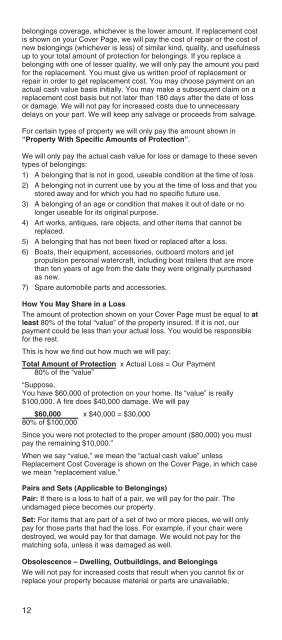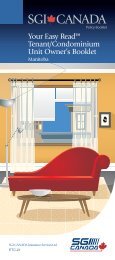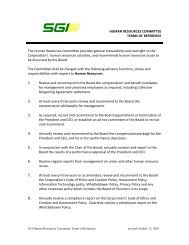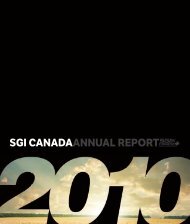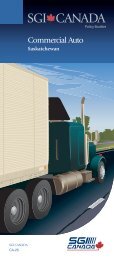General Dwelling Protector policy - SGI CANADA
General Dwelling Protector policy - SGI CANADA
General Dwelling Protector policy - SGI CANADA
Create successful ePaper yourself
Turn your PDF publications into a flip-book with our unique Google optimized e-Paper software.
elongings coverage, whichever is the lower amount. If replacement cost<br />
is shown on your Cover Page, we will pay the cost of repair or the cost of<br />
new belongings (whichever is less) of similar kind, quality, and usefulness<br />
up to your total amount of protection for belongings. If you replace a<br />
belonging with one of lesser quality, we will only pay the amount you paid<br />
for the replacement. You must give us written proof of replacement or<br />
repair in order to get replacement cost. You may choose payment on an<br />
actual cash value basis initially. You may make a subsequent claim on a<br />
replacement cost basis but not later than 180 days after the date of loss<br />
or damage. We will not pay for increased costs due to unnecessary<br />
delays on your part. We will keep any salvage or proceeds from salvage.<br />
For certain types of property we will only pay the amount shown in<br />
“Property With Specific Amounts of Protection”.<br />
We will only pay the actual cash value for loss or damage to these seven<br />
types of belongings:<br />
1) A belonging that is not in good, useable condition at the time of loss.<br />
2) A belonging not in current use by you at the time of loss and that you<br />
stored away and for which you had no specific future use.<br />
3) A belonging of an age or condition that makes it out of date or no<br />
longer useable for its original purpose.<br />
4) Art works, antiques, rare objects, and other items that cannot be<br />
replaced.<br />
5) A belonging that has not been fixed or replaced after a loss.<br />
6) Boats, their equipment, accessories, outboard motors and jet<br />
propulsion personal watercraft, including boat trailers that are more<br />
than ten years of age from the date they were originally purchased<br />
as new.<br />
7) Spare automobile parts and accessories.<br />
How You May Share in a Loss<br />
The amount of protection shown on your Cover Page must be equal to at<br />
least 80% of the total “value” of the property insured. If it is not, our<br />
payment could be less than your actual loss. You would be responsible<br />
for the rest.<br />
This is how we find out how much we will pay:<br />
Total Amount of Protection x Actual Loss = Our Payment<br />
80% of the “value”<br />
“Suppose,<br />
You have $60,000 of protection on your home. Its “value” is really<br />
$100,000. A fire does $40,000 damage. We will pay<br />
$60,000 x $40,000 = $30,000<br />
80% of $100,000<br />
Since you were not protected to the proper amount ($80,000) you must<br />
pay the remaining $10,000.”<br />
When we say “value,” we mean the “actual cash value” unless<br />
Replacement Cost Coverage is shown on the Cover Page, in which case<br />
we mean “replacement value.”<br />
Pairs and Sets (Applicable to Belongings)<br />
Pair: If there is a loss to half of a pair, we will pay for the pair. The<br />
undamaged piece becomes our property.<br />
Set: For items that are part of a set of two or more pieces, we will only<br />
pay for those parts that had the loss. For example, if your chair were<br />
destroyed, we would pay for that damage. We would not pay for the<br />
matching sofa, unless it was damaged as well.<br />
Obsolescence – <strong>Dwelling</strong>, Outbuildings, and Belongings<br />
We will not pay for increased costs that result when you cannot fix or<br />
replace your property because material or parts are unavailable,<br />
12


